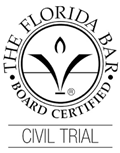From the ATLA Press Room
Under the Transportation Equity Act of 2005 (Public Law No. 109-59), Congress directed the National Highway Traffic Safety Administration (NHTSA) to establish rules to reduce deaths and injuries caused by vehicle rollover accidents and to specifically propose a new standard for how strong a vehicle’s roof must be.
Currently, 10,000 people die and 24,000 people are injured every year in rollover accidents. Instead of acting to significantly reduce injuries as Congress directed, NHTSA proposed a weak “roof crush standard” that leaves safety at the status quo—70% of vehicles on the road currently meet the new proposed standard.
Still worse, the proposed rule marks an unprecedented power grab by a federal agency, preempting all state requirements and state tort law. The result: as long as a car manufacturer meets the proposed standard, no individual may bring a claim in any court if they are injured or killed because of a badly made roof.
This is a fundamental change in auto safety that all Americans should be concerned about. Historically, federal regulations have been interpreted to set a minimum standard of safety. If a manufacturer met the minimum standard but still put a defective product out there that killed people, they could be held accountable. No longer.
The automakers know they can make safer vehicles, they know how to make safer vehicles, but they don’t want to spend the money. Instead this rule says to the industry, if you knowingly put a roof design on the market that happens to meet a bare minimum standard but is defective and a child is paralyzed in a rollover accident, the family can never hold the manufacturer accountable in court.
Weaknesses and Failures with NHTSA’s Proposed Standards
NHTSA ignored the Congressional directive and failed to make people safer. Congress demanded rules that would make people safer, that would significantly lessen the thousands of deaths and paralyzing injuries that occur when a car or truck rolls over. NHTSA freely admits that their proposed rule would save an estimated 13 to 44 lives out the 10,000 persons that die every year in rollover crashes. Can’t the federal agency responsible for the auto safety of all Americans do any better? The majority of cars currently on the road already meet the proposed rule’s “new” requirements, yet 10,000 thousand people die every year.
Under NHTSA’s proposed rule, there is no incentive to make safer cars. As long as the manufacturer complies with the minimum federal standard, consumers are left without the ability to hold manufacturers accountable in court for causing harm. The civil justice system demands only that people and companies act reasonably under the circumstances. Accountability acts as an incentive for manufacturers to make safe cars. In some cases it also prompts manufacturers to take defective vehicles off the market. With a weak federal standard and no accountability, where are the protections for consumers? Where is the improved safety standard Congress demanded?
Federal regulations alone cannot keep people safe in a fast-paced, ever-changing world. Federal regulations quickly become obsolete as rapidly evolving motor vehicle technology offers better and safer options. This is the first time in over 30 years the safety standard on roof crush resistance has been updated by NHTSA. With all of the technology that has been developed in the last 30 years, why is NHTSA claiming to only be able to save 13 to 44 lives? The American public cannot rely solely on a slow-moving federal agency to keep them safe. It is critical to the public health and safety that there be additional mechanisms—including the civil justice system—to maintain a high level of safety and ensure that we don’t have to wait another 30 years for enhanced safety.
The civil justice system uncovers information essential to public safety. NHTSA does not publicly disclose any data they gather from manufacturers in regards to vehicle defects. Thus, the only mechanism available to compel manufacturers to reveal to the public internal safety and testing data is the civil justice system. Through this process the public is made aware of problems and, as a result, is better able to protect themselves against dangerous products in the market.
NHTSA failed to follow the statutory directions provided by Congress. In the Transportation Equity Act of 2005 Congress specifically directed NHTSA to promulgate a roof strength rule that would require vehicle manufacturers to test roof strength on both the driver and passenger sides of the vehicle. Two-sided testing is important to ensure that all vehicle passengers are protected no matter which way the vehicle rolls. The proposed rule only requires driver’s side testing. By not following Congress’s directions, NHTSA is usurping the power of Congress while at the same time putting consumers at risk.
NHTSA usurped the authority of Congress, state legislatures and state courts. NHTSA expressly states their intention to override all state requirements and all common law developed by both state and federal courts. NHTSA does this without Congressional authority, without constitutional authority, and without complying with Executive Order 13132, which requires NHTSA to consult with the states before proposing a rule that would substantially affect them. Instead, NHTSA purports to take away the right of all Americans to bring a claim in any court against a car manufacturer who meets the new, low standard. NHTSA’s attempt to override all other rollover safety determinations of the state and federal courts is nothing more than an agency power grab and should not be tolerated by Congress or the American public.
NHTSA’s standards are a floor, not a ceiling. Congress, in the Safety Act, delegated certain vehicle safety responsibilities to NHTSA. This act defines “motor vehicle safety standard” as a minimum standard for motor vehicle performance. (49 U.S.C.A. § 30102) Thus, NHTSA’s regulations provide minimum requirements that cars must meet in order to be sold to consumers. State and federal courts should not suddenly be prohibited from finding a manufacturer liable when it is proven that a manufacturer reasonably could have and should have done something additional to avoid causing harm. Because the majority of cars on the road already meet the proposed standard, and in some cases are still found to be defective and to have caused injuries, this rule should constitute the minimum, not the maximum safety standard.






